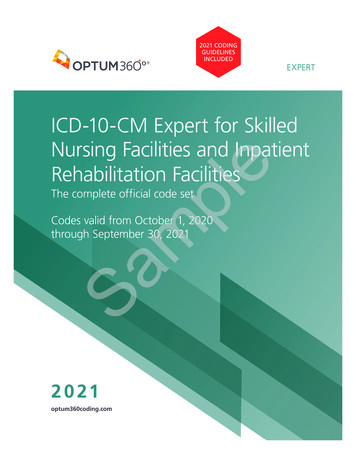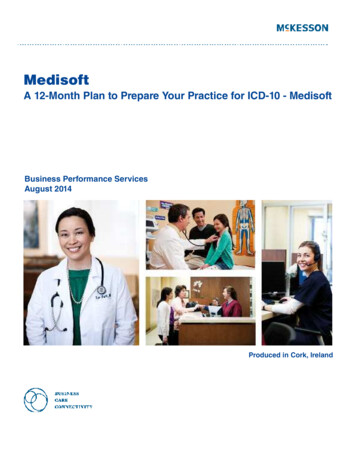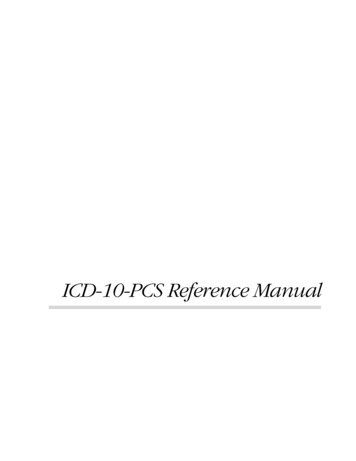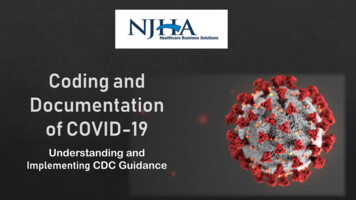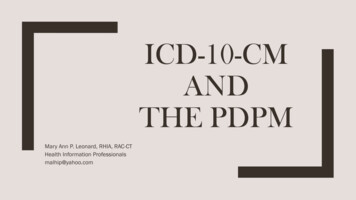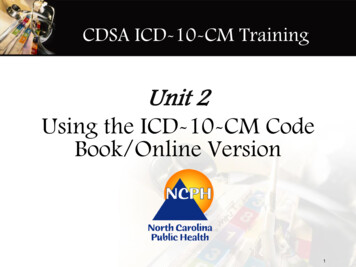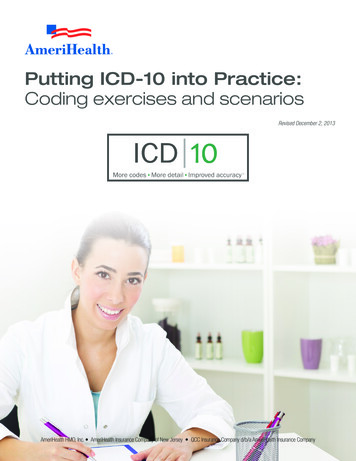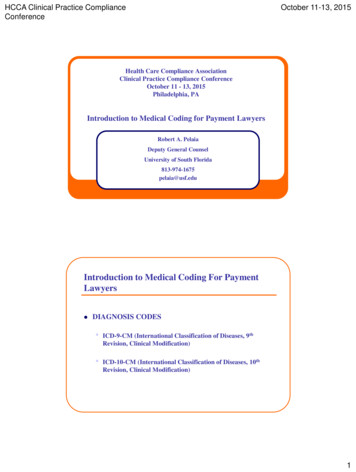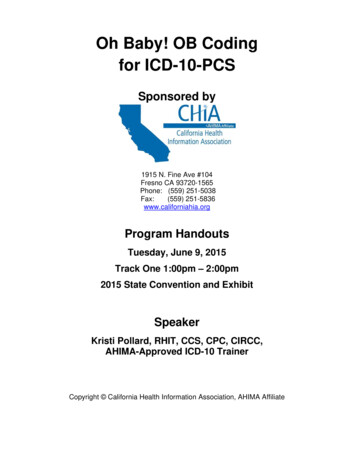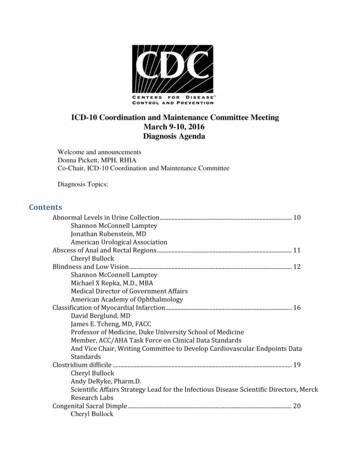
Transcription
ICD-10 Coordination and Maintenance Committee MeetingMarch 9-10, 2016Diagnosis AgendaWelcome and announcementsDonna Pickett, MPH, RHIACo-Chair, ICD-10 Coordination and Maintenance CommitteeDiagnosis Topics:ContentsAbnormal Levels in Urine Collection . 10Shannon McConnell LampteyJonathan Rubenstein, MDAmerican Urological AssociationAbscess of Anal and Rectal Regions . 11Cheryl BullockBlindness and Low Vision. 12Shannon McConnell LampteyMichael X Repka, M.D., MBAMedical Director of Government AffairsAmerican Academy of OphthalmologyClassification of Myocardial Infarction . 16David Berglund, MDJames E. Tcheng, MD, FACCProfessor of Medicine, Duke University School of MedicineMember, ACC/AHA Task Force on Clinical Data StandardsAnd Vice Chair, Writing Committee to Develop Cardiovascular Endpoints DataStandardsClostridium difficile . 19Cheryl BullockAndy DeRyke, Pharm.D.Scientific Affairs Strategy Lead for the Infectious Disease Scientific Directors, MerckResearch LabsCongenital Sacral Dimple . 20Cheryl Bullock
ICD-10 Coordination and Maintenance Committee MeetingMarch 9-10, 2016Dermatomyositis . 21David Berglund, MDAdam Schiffenbauer, MDNational Institutes of Health/National Institute of Environmental Health SciencesEctopic Pregnancy . 23Traci RamirezEncounter for Prophylactic Salpingectomy . 25Traci RamirezExercise Counseling . 26Shannon McConnell LampteyGestational Alloimmune Liver Disease. 27Cheryl BullockGingival recession . 28Shannon McConnell LampteyHepatic Encephalopathy . 29Shannon McConnell LampteyIn utero exposure to Diethylstilbestrol (DES) . 35Donna PickettLacunar Infarction . 37Cheryl BullockLump in the Breast . 38Traci RamirezMultiple Pregnancy - Triplets and Above - Amnion and Chorion Equal to Fetus Number. 39Cheryl BullockNon-Healing and Slow Healing Wounds . 42David Berglund, MDNon-Pressure Chronic Ulcer Severity . 43David Berglund, MDPediatric Cryptorchidism. 46Shannon McConnell LampteyPost-Operative Seroma . 48David Berglund, MDRisk Level for Dental Carries . 55Traci RamirezType 2 diabetes mellitus with ketoacidosis . 56David Berglund, MDZika Virus . 57Donna PickettICD-10-CM TABULAR OF DISEASES - PROPOSED ADDENDA . 58ICD-10-CM INDEX OF DISEASES - PROPOSED ADDENDA . 602
ICD-10 Coordination and Maintenance Committee MeetingMarch 9-10, 2016ICD-10 TIMELINEA timeline of important dates in the ICD-10 process is described below:March 9 – 10, 2016ICD-10 Coordination and Maintenance Committee Meeting.March, 2016Webcast of the March 9-10, 2016 ICD-10 Coordination and MaintenanceCommittee meeting will be posted on the CMS webpage as erials.htmlSummary report of the Diagnosis part of the March 10, 2016 ICD-10Coordination and Maintenance Committee meeting report will be postedon the NCHS webpage as follows:http://www.cdc.gov/nchs/icd/icd9cm maintenance.htmApril 1, 2016There were no requests for ICD-10 codes to capture new diseases ortechnology for implementation on April 1, 2016. Therefore, there will beno new ICD-10 codes implemented on April 1, 2016.April 8, 2016Deadline for receipt of public comments on proposed new codes andrevisions discussed at the March 9–10, 2016 ICD-10 Coordinationand Maintenance Committee meetings for implementation onOctober 1, 2016.April 2016Notice of Proposed Rulemaking to be published in the Federal Registeras mandated by Public Law 99-509. This notice will include references tothe complete and finalized FY 2017 ICD-10-CM diagnosis and ICD-10PCS procedure codes. It will also include proposed revisions to the MSDRG system based on ICD-10-CM/PCS codes on which the public maycomment. The proposed rule can be accessed rvicePayment/AcuteInpatientPPS/index.html?redirect /AcuteInpatientPPS/IPPS/list.aspJune 2016Final addendum posted on web pages as follows:Diagnosis addendum - http://www.cdc.gov/nchs/icd/icd10cm.htmProcedure addendum lJuly 15, 2016Deadline for requestors: Those members of the public requestingthat topics be discussed at the September 13–14, 2016 ICD-10Coordination and Maintenance Committee meeting must have theirrequests submitted to CMS for procedures and NCHS for diagnoses.3
ICD-10 Coordination and Maintenance Committee MeetingMarch 9-10, 2016August 1, 2016Hospital Inpatient Prospective Payment System final rule to be publishedin the Federal Register as mandated by Public Law 99-509. This rule willalso include links to all the final codes to be implemented on October 1,2016.This rule can be accessed rvicePayment/AcuteInpatientPPS/index.html?redirect /AcuteInpatientPPS/IPPS/list.aspAugust 2016Tentative agenda for the Procedure part of the September 13–14, 2016ICD-10 Coordination and Maintenance Committee meeting will beposted on the CMS webpage at s.htmlTentative agenda for the Diagnosis part of the September 13 –14, 2016ICD-10 Coordination and Maintenance Committee meeting will beposted on the NCHS webpage at http://www.cdc.gov/nchs/icd/icd9cm maintenance.htmFederal Register notice for the September 13–14, 2016 ICD-10Coordination and Maintenance Committee meeting will be published.This will include the tentative agenda.August 5, 2016On-line registration opens for the September 13-14, 2016 ICD-10Coordination and Maintenance Committee meeting ember 2, 2016Because of increased security requirements, those wishing to attend theSeptember 13-14, 2016 ICD-10 Coordination and MaintenanceCommittee meeting must register for the meeting online ndees must register online by September 2, 2016; failure to do somay result in lack of access to the meeting.September 13 –14,2016ICD-10 Coordination and Maintenance Committeemeeting.Those who wish to attend the ICD-10 Coordination and MaintenanceCommittee meeting must have registered for the meeting online bySeptember 2, 2016. You must bring an official form of pictureidentification (such as a driver’s license) in order to be admitted to thebuilding.October 2016Webcast of the September 13–14, 2016 ICD-10 Coordination andMaintenance Committee meeting will be posted on the CMS webpage asfollows:4
ICD-10 Coordination and Maintenance Committee MeetingMarch 9-10, erDiagnosticCodes/meetings.htmlSummary report of the Diagnosis part of the September 13–14, 2016ICD-10 Coordination and Maintenance Committee meeting report will beposted on NCHS homepage as follows:http://www.cdc.gov/nchs/icd/icd9cm maintenance.htmOctober 1, 2016New and revised ICD-10-CM and ICD-10-PCS codes go into effect alongwith DRG changes. Final addendum available on web pages as follows:Diagnosis addendum - http://www.cdc.gov/nchs/icd/icd10cm.htmProcedure addendum r 16, 2016Deadline for receipt of public comments on proposed new codesdiscussed at the September 13-14, 2016 ICD-10 Coordination andMaintenance Committee meetings for implementation on April 1,2017.November 2016Any new ICD-10 codes required to capture new technology that will beimplemented on the following April 1 will be announced. Information onany new codes to be implemented April 1, 2017 will be posted on thefollowing tp://www.cms.gov/Medicare/Coding/ICD10/November 13, 2016Deadline for receipt of public comments on proposed new codes andrevisions discussed at the September 13-14, 2016 ICD-10Coordination and Maintenance Committee meetings forimplementation on October 1, 2017.5
ICD-10 Coordination and Maintenance Committee MeetingMarch 9-10, 2016Webcast and Dial-In Information The meeting will begin promptly at 9am ET and will be webcast.Toll-free dial-in access is available for participants who cannot join the webcast:Phone: 1-877-267-1577; Meeting ID: 993 921 961.This meeting is being webcast via CMS at http://www.cms.gov/live/. By your attendance, you aregiving consent to the use and distribution of your name, likeness and voice during the meeting. Youare also giving consent to the use and distribution of any personally identifiable information that you orothers may disclose about you during the meeting. Please do not disclose personal health information.NOTE: In compliance to The Real ID Act, enacted in 2005, the following states/territories: AmericanSamoa, Louisiana, Minnesota, New Hampshire, and New York will not gain access into any FederalAgencies using the above states driver’s license or ID. This means CMS visitors from thesestates/territories will need to provide alternative proof of identification (such as a passport) to gainentrance into Baltimore-based CMS building.Proposals for diagnosis code topics will be led by the Centers for Disease Control (CDC) and arescheduled to begin on March 9, 2016 following procedure code proposals. They will continue untilapproximately 2:00 pm on March 10, 2016. Please visit CDCs website for the Diagnosis agendalocated at the following address:http://www.cdc.gov/nchs/icd/icd9cm maintenance.htm6
ICD-10 Coordination and Maintenance Committee MeetingMarch 9-10, 2016Contact InformationMailing address:National Center for Health StatisticsICD-9-CM Coordination and Maintenance Committee3311 Toledo RoadHyattsville, Maryland 20782Fax: (301) 458-4022Comments on the diagnosis proposals presented at the ICD Coordination andMaintenance Committee meeting should be sent to the following email address:nchsicd10CM@cdc.govDonna Pickett(301) 458-4434David Berglund(301) 458-4095Cheryl Bullock(301) 458-4297Shannon McConnell-LampteyTraci Ramirez(301) 458-4612(301) 458-4454NCHS Classifications of Diseases web page:http://www.cdc.gov/nchs/icd.htmPlease consult this web page for updated information.7
ICD-10 Coordination and Maintenance Committee MeetingMarch 9-10, 2016Partial Code Freeze for ICD-9-CM and ICD-10The ICD-9-CM Coordination and Maintenance Committee implemented a partial freeze of theICD-9-CM and ICD-10 (ICD-10-CM and ICD-10-PCS) codes prior to the implementation ofICD-10. The partial freeze is scheduled to end one year after the implementation of ICD-10.There was considerable support for this partial freeze. On April 1, 2014, the Protecting Access toMedicare Act of 2014 (PAMA) (Pub. L. No. 113-93) was enacted, which said that the Secretarymay not adopt ICD-10 prior to October 1, 2015. Accordingly, the U.S. Department of Health andHuman Services issued a final rule on August 4, 2014 that changed the compliance date for ICD10 from October 1, 2014 to October 1, 2015. The final rule also requires HIPAA covered entitiesto continue to use ICD-9-CM through September 30, 2015. Links to the final rule are provided athttp://www.cms.gov/Medicare/Coding/ICD10/Statute Regulations.html.The partial freeze will be implemented as follows: The last regular, annual updates to both ICD-9-CM and ICD-10 code sets were made on October1, 2011. On October 1, 2012, October 1, 2013, and October 1, 2014 there were only limited code updatesto both the ICD-9-CM and ICD-10 code sets to capture new technologies and diseases as requiredby section 503(a) of Pub. L. 108-173. On October 1, 2015, there will be only limited code updates to ICD-10 code sets to capture newtechnologies and diagnoses as required by section 503(a) of Pub. L. 108-173. There will be noupdates to ICD-9-CM, as it will no longer be used for reporting. On October 1, 2016 (one year after implementation of ICD-10), regular updates to ICD-10 willbegin.The ICD-9-CM Coordination and Maintenance Committee will continue to meet twice a yearduring the partial freeze. At these meetings, the public will be asked to comment on whether ornot requests for new diagnosis or procedure codes should be created based on the criteria of theneed to capture a new technology or disease. Any code requests that do not meet the criteria willbe evaluated for implementation within ICD-10 on and after October 1, 2016 once the partialfreeze has ended.8
ICD-10 Coordination and Maintenance Committee MeetingMarch 9-10, 2016Continuing Education CreditsContinuing education credits may be awarded by the American Academy of ProfessionalCoders (AAPC) or the American Health Information Management Association (AHIMA) forparticipation in CMS/NCHS ICD-10 Coordination and Maintenance (C&M) CommitteeMeeting.Continuing Education Information for American Academy of Professional Coders(AAPC)If you plan to attend or participate via telephone the ICD-10 Coordination and Maintenance(C&M) Committee Meeting, you should be aware that CMS /NCHS do not provide certificatesof attendance for these calls. Instead, the AAPC will accept your printed topic packet as proofof participation. Please retain a your topic packet copy as the AAPC may request them for anyconference call you entered into your CEU Tracker if you are chosen for CEU verification.Members are awarded one (1) CEU per hour of participation.Continuing Education Information for American Health Information ManagementAssociation (AHIMA)AHIMA credential-holders may claim 1 CEU per 60 minutes of attendance at an educationalprogram. Maintain documentation about the program for verification purposes in the event of anaudit. A program does not need to be pre-approved by AHIMA, nor does a CEU certificate needto be provided, in order to claim AHIMA CEU credit. For detailed information about AHIMA'sCEU requirements, see the Recertification Guide on AHIMA's web site.Please note: The statements above are standard language provided to NCHS by theAAPC and the AHIMA. If you have any questions concerning either statement, pleasecontact the respective organization, not NCHS.9
ICD-10 Coordination and Maintenance Committee MeetingMarch 9-10, 2016Abnormal Levels in Urine CollectionThe American Urological Association (AUA) is proposing the creation of new codes for specificabnormal findings in urine collection. One of the most commonly used diagnostic tests for patientswho form kidney stones is a urine collection looking for abnormal levels of certain substances, so thatabnormalities can be treated to reduce the risk of future stone formation.For example, patients with high levels of urine calcium (hypercalciuria) may be treated with thiazidediuretics, those with high levels of oxalate (hyperoxaluria) may be treated with dietary changes ormedications, those with low citrate levels (hypocitraturia) may be treated with citrate medications, andthose with high levels of uric acid (hyperuricosuria) may be treated with dietary measures and possiblytreatment of an underlying condition.The existing code E72.53, hyperoxaluria, is for a childhood inborn error of metabolism primaryhyperoxaluria, which is a diagnostic condition that can be determined by genetic testing. This isdifferent than someone who has an idiopathic or diet-induced mild elevation of oxalate in the urine whodoes not have the genetic inborn error of metabolism.To help better capture the unique characteristics of these abnormal findings and to help with researchand public health, AUA is requesting the following ICD-10-CM tabular changes.TABULAR MODIFICATIONSR82AddOther and unspecified abnormal findings in urineR82.9 Other and unspecified abnormal findings in urineR82.99 Other abnormal findings in urineExcludes1: Primary Hyperoxaluria (E72.53)DeleteDeleteDeleteCells and casts in urineCrystalluriaMelanuriaNew CodeNew CodeNew CodeNew CodeNew r abnormal findings in urineCells and casts in urineCrystalluriaMelanuria10
ICD-10 Coordination and Maintenance Committee MeetingMarch 9-10, 2016Abscess of Anal and Rectal RegionsMost experts categorize abscesses of the anal and rectal regions according to their anatomic location:perianal, ischiorectal, intersphincteric, and supralevator. Perianal abscesses are the most common,comprising over half of all anorectal abscesses. They are superficially located adjacent to the anus.Ischiorectal abscesses are the next most common location, located deep to the superficial subcutaneousfascia in the perirectal region. Superficial to the levator and anal sphincter muscles in the ischiorectalspace. Intersphincteric abscesses occur between the external and internal sphinter muscles.Supralevator abscesses are located deep to the levator muscle in the true pelvis. The anatomic detailsdetermine appropriate treatment and accurate prognostication.This proposal was originally presented at the September 2015 C&M meeting at the request of ThePatient Assessment and Outcome Committee of the American Association for the Surgery of Trauma.Modifications have been made to the proposal based on public comments and resubmitted for theproposed tabular modifications.TABULAR MODIFICATIONSK61Abscess of anal and rectal regionsReviseAddIncludes: Abscess of anal and rectal regionsCellulitis of anal and rectal regionsK61.0 Anal abscessPerianal abscessExcludes12: Intrasphincteric abscess (K61.4)Intersphincteric abscess (K61.4)New sub-subcategoryDeleteAddK61.3 Ischiorectal abscessAbscess of ischiorectal fossaIschioanal abscessNew codeNew codeAddK61.31 Horseshoe AbscessK61.32 Ischiorectal Abscess,NOSAbscess of ischiorectal fossaAddK61.4 Intrasphincteric abscessIntersphincteric abscessNew codeK61.5 Supralevator abscess11
ICD-10 Coordination and Maintenance Committee MeetingMarch 9-10, 2016Blindness and Low VisionThe World Health Organization (WHO) uses blindness as a term that includes multiple categories ofvisual loss. Typically, when used in the U.S. the word “blindness” generally means total blindness inboth eyes. Categories of visual impairment, recognized by WHO and listed in ICD-10-CM, indicatedistinctly different levels of impairment and usable residual vision in patients with reduced vision.ICD-10-CM describes each category of reduced vision in the listing, but then collapses them,eliminating the precision required for rehabilitation. The loss of precision makes it impossible todemonstrate significant progression of vision loss.a. An individual whose visual acuity drops from 20/70 to 20/320 within the same calendar yearmight not receive further rehabilitation intervention, although their entire function, safetyand wellbeing is compromised, because the severity of the decline would not be detected bythe code set.b. An individual whose visual acuity drops from 20/500 to total blindness could not receivefurther rehabilitation intervention although their needs are greatly different and theirfunction, mental health, wellbeing and safety compromised, because they demonstrate nochange when using the codes.The American Academy of Ophthalmology is proposing new codes for blindness and low vision toallow more granular differentiation of categories for visual impairment. They are proposing thefollowing tabular modifications.TABULAR MODIFICATIONSH54NewsubcategoryNew codeNew codeNew codeNew codeNew codeNew codeNew codeNew codeNew codeBlindness and low visionH54.0 Blindness, both eyesH54.0X33 Blindness right eye category 3, Blindness left eyecategory 3H54.0X34 Blindness right eye category 3, Blindness left eyecategory 4H54.0X35 Blindness right eye category 3, Blindness left eyecategory 5H54.0X44 Blindness right eye category 4, Blindness left eyecategory 4H54.0X43 Blindness right eye category 4, Blindness left eyecategory 3H54.0X45 Blindness right eye category 4, Blindness left eyecategory 5H54.0X55 Blindness right eye category 5, Blindness left eyecategory 5H54.0X53 Blindness right eye category 5, Blindness left eyecategory 3H54.0X54 Blindness right eye category 5, Blindness left eyecategory 412
ICD-10 Coordination and Maintenance Committee MeetingMarch 9-10, 2016H54.1 Blindness, one eye, low vision other eyeH54.10 Blindness, one eye, low vision other eye, unspecifiedNewsub-subcategoryNew codeNew codeNew codeNew codeNew codeNew codeNewsub-subcategoryNew codeNew codeNew codeNew codeNew codeNew codeNewsubcategoryNew codeNew codeNew codeNew codeH54.11 Blindness right eye, low vision left eyeH54.1131 Blindness right eye category 3, low visionleft eye category 1H54.1132 Blindness right eye category 3, low visionleft eye category 2H54.1141 Blindness right eye category 4, low visionleft eye category 1H54.1142 Blindness right eye category 4, low visionleft eye category 2H54.1151 Blindness right eye category 5, low visionleft eye category 1H54.1152 Blindness right eye category 5, low visionleft eye category 2H54.12 Blindness left eye, low vision right eyeH54.1213 Blindness right eye category 1, low visionleft eye category 3H54.1214 Blindness right eye category 1, low visionleft eye category 4H54.1215 Blindness right eye category 1, low visionleft eye category 5H54.1223 Blindness right eye category 2, low visionleft eye category 3H54.1224 Blindness right eye category 2, low visionleft eye category 4H54.1125 Blindness right eye category 2, low visionleft eye category 5H54.2 Low Vision, both eyesH54.2X11 Blindness right eye category 1, Blindness left eyecategory 1H54.2X12 Blindness right eye category 1, Blindness left eyecategory 2H54.2X22 Blindness right eye category 2, Blindness left eyecategory 2H54.2X21 Blindness right eye category 2, Blindness left eyecategory 113
ICD-10 Coordination and Maintenance Committee MeetingMarch 9-10, 2016H54.3 Unqualified visual loss both eyesH54.4 Blindness, one eyeH54.40 Blindness, one eye, unspecified other eyeNewsub-subcategoryNew codeNew codeNew codeNewsub-subcategoryNew codeNew codeNew codeH54.41 Blindness right eye, normal vision left eyeH54.413A Blindness right eye category 3, normal visionleft eyeH54.414A Blindness right eye category 4, normal visionleft eyeH54.415A Blindness right eye category 5, normal visionleft eyeH54.42 Blindness left eye, normal vision right eyeH54.42A3 Blindness left eye category 3, normal visionright eyeH54.42A4 Blindness left eye category 4, normal visionright eyeH54.42A5 Blindness left eye category 5, normal visionright eyeH54.5 Low vision, one eyeH54.50 Low vision one eye, unspecified eyeNewsub-subcategoryNew codeNew codeNewsub-subcategoryNew codeNew codeH54.51 Low vision right eye, normal vision left eyeH54.511A Low vision right eye category 1, normalvision left eyeH54.512A Low vision right eye category 2, normalvision left eyeH54.52 Low vision left eye, normal vision right eyeH54.52A1 Low vision left eye category 1, normal visionright eyeH54.52A2 Low vision left eye category 2, normal visionright eye14
ICD-10 Coordination and Maintenance Committee MeetingMarch 9-10, 2016H54.6 Unqualified visual loss, one eyeH54.60 Unqualified visual loss, unspecified eyeH54.61 Unqualified visual loss, right eye, normal vision left eyeH54.62 Unqualified visual loss, left eye, normal vision right eyeNote: The table below gives a classification of severity of visual impairment recommended by aWHO Study Group on the Prevention of Blindness, Geneva, 6-10 November 1972.The term 'low vision' in category H54 comprises categories 1 and 2 of the table, the term'blindness' categories 3, 4 and 5, and the term 'unqualified visual loss' category 9.If the extent of the visual field is taken into account, patients with a field no greater than10 but greater than 5 around central fixation should be placed in category 3 and patientswith a field no greater than 5 around central fixation should be placed in category 4, evenif the central acuity is not impaired.Category of visualimpairmentVisual acuity with best possible correctionMaximum less than:Minimum equal to or betterthan:16/183/10 (0.3)20/706/601/10 (0.1)20/20026/601/10 (0.1)20/2003/601/20 (0.5)20/40033/601/60 (finger counting at onemeter)1/50 (0.02)5/300 (20/1200)1/20 (0.05)20/40041/60 (finger counting at onemeter)1/50 (0.02)5/3005No light perception9Undetermined or unspecified15Light perception
ICD-10 Coordination and Maintenance Committee MeetingMarch 9-10, 2016Classification of Myocardial InfarctionThe 2012 expert consensus document of the Joint European Society of Cardiology / American Collegeof Cardiology Foundation / American Heart Association / World Heart Federation Task Force for theUniversal Definition of Myocardial Infarction is the authoritative, world-wide consensus of theprofessional socieites representing the cardiovascular communities regarding classification ofmyocardial infarction (MI) (1). By way of background, in 2000, the First Global MI Task Forcepresented a new definition of MI, specifically that myocardial necrosis as detected by cardiacbiomarkers in the setting of myocardial ischemia should be labelled as an MI (2). These principles werefurther refined by the Second Global MI Task Force, leading to the Universal Definition of MyocardialInfarction Consensus Document in 2007, which emphasized the different conditions which might resultin an MI (3). Following the second consensus document, the development of increasingly sensitiveassays for the biomarkers of myocardial necrosis mandated further revision, particularly acknowledgingthat the detection of these biomarkers occurs not infrequently in the setting of the critically ill, afterpercutaneous coronary intervention and after cardiac surgery. The Third Global MI Task Force wasconvened to integrate these insights with new clinical outcomes data into a universal classification,particularly the establishment of the diagnosis of MI based on cardiac biomarkers and the prognosticimplications of MI in various clinical contexts (1). In 2014, the classification was formally developedby the ACC/AHA Task Force on Data Standards as a controlled terminology for the purposes ofinteroperability among electronic health information systems (4).In brief, the classification is as follows (1):1. Spontaneous myocardial infarction (MI Type 1) is a clinical event typically caused by rupture orerosion of an atherosclerotic plaque resulting in thrombus formation in one or more of the coronaryarteries. This is the prototypic “heart attack” for which there are extensive guidelines regardingevaluation and management. ST Elevation MI (STEMI) and Non ST Elevation MI (NSTEMI) share thesame pathophysiology, and both are considered Type 1 MIs.2. Myocardial infarction secondary to ischemic imbalance (myocardial demand exceeding supply) isdefined as MI Type 2. This is where a condition other than coronary artery disease results in theimbalance between myocardial oxygen supply and / or demand. Of note, coronary vasospasm and/orendothelial dysfunction also have the potential to cause a Type 2 MI. Of note, the treatment guidelinesfor Type 1 MI are generally NOT applicable to the management of a Type 2 MI.3. Patients who present with death from a presumed cardiac etiology (i.e., symptoms or signssuggestive of myocardial ischemia, such as typical chest pain and / or ECG changes) but withoutconfirmatory cardiac biomarkers being available, are classified as having an MI Type 3.4. Myocardial infarction associated with revascularization procedures are classified as MI Types 4 and5, with Type 4 MI occurring in the context of percutaneous coron
April 1, 2016 There were no requests for ICD-10 codes to capture new diseases or technology for implementation on April 1, 2016. Therefore, there will be no new ICD-10 codes implemented on April 1, 2016. April 8, 2016 Deadline for receipt of public comments on proposed new codes and revisions discussed at the March 9-10, 2016 ICD-10 Coordination
